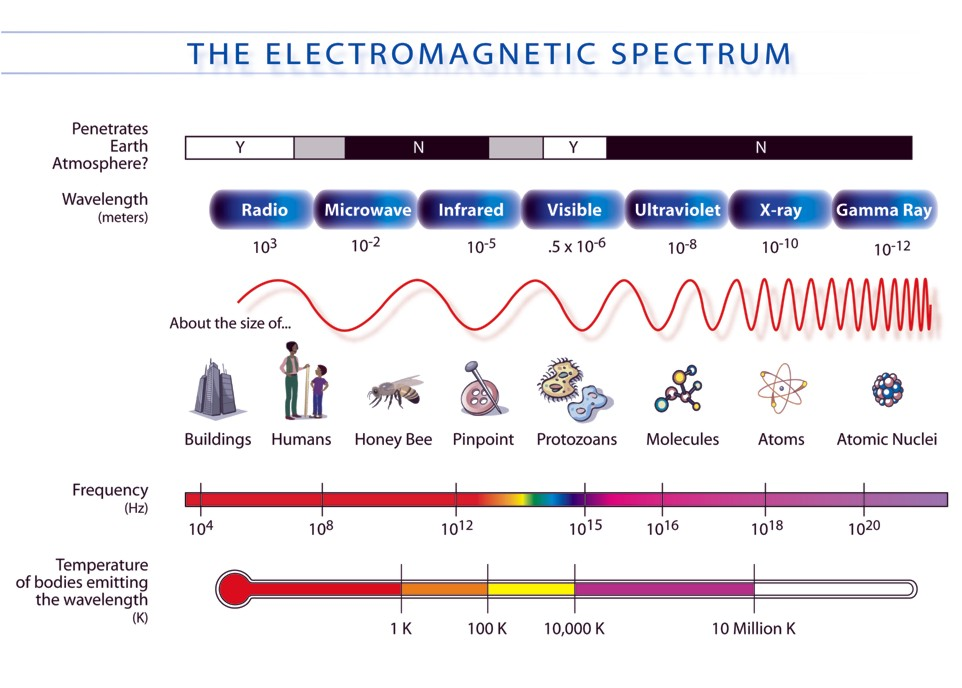S
Saarah Hasan
AP Physics 2 🧲
61 resourcesSee Units
6.2: Electromagnetic Waves
We briefly mentioned electromagnetic waves in 6.1, but let’s review a little and get a bit more in depth. Once again, what is an electromagnetic wave?
An electromagnetic wave is a wave that’s capable of transmitting its energy through a vacuum; electromagnetic waves are produced by the vibrations of charged particles, don’t require a medium to travel, and are always transverse.
Some new stuff to dig on: electromagnetic waves are made up of electric and magnetic fields that oscillate perpendicular to each other. As shown in the image below, both fields are perpendicular to each other and perpendicular to their direction of motion as well.

Taken from Wikimedia Commons
Another thing to remember: When electromagnetic waves travel through a vacuum, they all travel at a constant speed c, which equals 3*10^8m/s (the speed of light).
v=λ*f becomes c=λ*f
The Electromagnetic Spectrum🌈
There’s a broad spectrum of wavelengths and frequencies that electromagnetic waves cover, and electromagnetic waves can be categorized by these two characteristics. The entire rage of waves is called the electromagnetic (EM) spectrum. Types of waves on the EM spectrum include:
- Radio waves
- Microwaves
- Infrared
- Visible light
- Ultraviolet
- X-rays
- Gamma rays

Taken from Wikimedia Commons
The narrow band of wavelengths that the human eye can see is the visible light spectrum, whose colors in order of increasing wave frequency are red, orange, yellow, green, blue, and violet- remembered as ROYGBV. It’d be best to familiarize yourself with the names of the major categories of EM waves and ROYGBV.
A Connection to Everyday Life
Electromagnetic waves to the left of the spectrum—UV rays, X-rays, gamma rays—have high frequencies. Due to their high frequencies, these types of radiation have high energies, which can be detrimental to our health if precautions aren’t taken. That’s why we wear sunscreen whenever we go out and why lead shields are placed over parts of our body that aren’t being imaged whenever we get an X-ray.
Electromagnetic waves to the right of the spectrum—infrared rays, microwaves, radio waves—have low frequencies, so radiation from these types isn’t dangerous and doesn’t really affect our health.
Practice Problems:🧩
1. In the electromagnetic spectrum, rank the following electromagnetic waves in terms of increasing wavelength.


2. For the five types of electromagnetic radiation listed above, which of the following correctly describes the way in which wavelength, frequency and speed, change as one goes from the left to right on the list?
| Wavelength | Frequency | Speed | |
| A | Decreases | Decreased | Decreases |
| B | Decreases | Increased | Remains the Same |
| C | Increases | Decreases | Remains the Same |
| D | Increases | Decreases | Increases |
| E | Increased | Increases | Increases |
Answers:
- E: λ changes the opposite of frequencies (high freq = low λ) … based on this and knowledge of the EM spectrum, the answer is E.
- B: Known facts about the EM spectrum.
Browse Study Guides By Unit
💧Unit 1 – Fluids
🔥Unit 2 – Thermodynamics
⚡️Unit 3 – Electric Force, Field, & Potential
💡Unit 4 – Electric Circuits
🧲Unit 5 – Magnetism & Electromagnetic Induction
🔍Unit 6 – Geometric & Physical Optics
⚛️Unit 7 – Quantum, Atomic, & Nuclear Physics
✏️Frequently Asked Questions
📆Big Reviews: Finals & Exam Prep

Fiveable
Resources
© 2023 Fiveable Inc. All rights reserved.